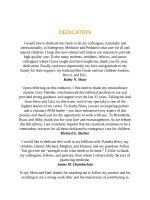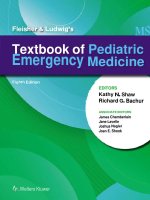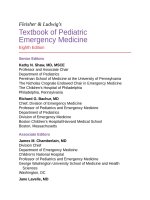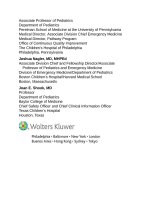Pediatric emergency medicine trisk 0316 0316
Bạn đang xem bản rút gọn của tài liệu. Xem và tải ngay bản đầy đủ của tài liệu tại đây (101.53 KB, 1 trang )
The disease process must also be considered in this decision. The patient with
developing petechiae, fever, and hypotension should not be transported several
hours by ground if a quicker method of transport is available. Thomas et al.
reported an association between helicopter transport and increased survival in
blunt trauma patients (adult and pediatric). However, short air transport for a
relatively stable patient may not be an appropriate use of resources or be in the
patient’s or team’s best interest. Eckstein et al. and Arfken et al. suggested that
helicopter services may be overused and may not influence outcomes when
compared with alternative modes of transport. One must be cognizant of the
many issues surrounding the mode of transport choices; these choices should be
individualized for each patient.
Although appropriate medical care should never be withheld for financial
reasons, a cost comparison of air and ground transports is often useful. In general,
RW (helicopter) transport costs two to three times more than ground transport for
local transfers. However, the savings may potentially offset the cost in time
saved. A helicopter, which can land directly at the patient’s location, is much
quicker than an ambulance, which takes a less direct route. If the helicopter
cannot land directly at the referring or receiving center, however, the potential
time savings by air transport may be limited. In that situation, in addition to the
decreased time savings, the patient may be placed at greater risk due to the
multiple transfers involved, as the patient must first be loaded onto a stretcher for
an additional ambulance ride to a remote helicopter landing zone, then unloaded
from the EMS stretcher to into the helicopter. The riskiest time for the patient is
often during transfer from stretcher to stretcher or vehicle to vehicle ( Fig. 11.6 ).
These transfers increase opportunities for dislodgement of endotracheal tubes,
central venous catheters, chest tubes, and other lifesaving equipment.
Communication center personnel, transport team members, and medical control
(command) physicians should all be aware of times, distances, and particular
medical and logistical nuances of each referring institution and location.
MEDICAL OVERSIGHT
There are two types of medical oversight—direct (online) and indirect (offline).
Both models require initial and ongoing input by physicians, and each model has
its own risks and benefits.
Direct Medical Control
Direct medical oversight refers to the real-time provision of supervision or
authorization of care activities by physicians who are either on-site, or, more
commonly, using radio or phone communication with the transport team at the









